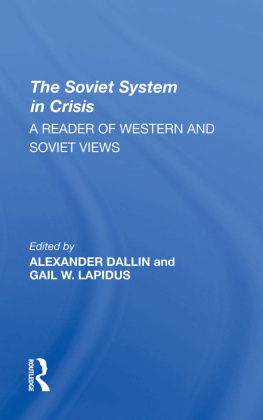WOMEN, WORK, AND FAMILY
IN THE SOVIET UNION
Women, Work, and Family
In the Soviet Union
Edited with an introduction by
Gail Warshofsky Lapidus
First published 1982 by M.E. Sharpe
Reissued 2018 by Routledge
2 Park Square, Milton Park, Abingdon, Oxon OX14 4RN
711 Third Avenue, New York, NY 10017, USA
Routledge is an imprint of the Taylor & Francis Group, an informa business
Copyright 1982 by Taylor & Francis
Russian texts are translated by arrangement with VAAP, the USSR Copyright Agency.
Translated by Vladimir Talmy.
No part of this book may be reprinted or reproduced or utilised in any form or by any electronic, mechanical, or other means, now known or hereafter invented, including photocopying and recording, or in any information storage or retrieval system, without permission in writing from the publishers.
Notices
No responsibility is assumed by the publisher for any injury and/or damage to persons or property as a matter of products liability, negligence or otherwise, or from any use of operation of any methods, products, instructions or ideas contained in the material herein.
Practitioners and researchers must always rely on their own experience and knowledge in evaluating and using any information, methods, compounds, or experiments described herein. In using such information or methods they should be mindful of their own safety and the safety of others, including parties for whom they have a professional responsibility.
Product or corporate names may be trademarks or registered trademarks, and are used only for identification and explanation without intent to infringe.
Publisher's Note
The publisher has gone to great lengths to ensure the quality of this reprint but points out that some imperfections in the original copies may be apparent.
Disclaimer
The publisher has made every effort to trace copyright holders and welcomes correspondence from those they have been unable to contact.
A Library of Congress record exists under LC control number: 81009281
ISBN 13: 978-0-873-32255-3 (hbk)
ISBN 13: 978-1-315-17929-2 (ebk)
In the course of the past fifteen years, questions of female employment and its impact on family structure and demographic trends have come to the forefront of both scholarly research and public controversy in the USSR. These questions have already provoked a series of major new policy initiatives, most notably those announced at the Twenty-sixth Party Congress in 1981, and they will continue to pose policy dilemmas for the Soviet political agenda throughout the 1980s and beyond.
This volume is designed to offer an overview of current Soviet concerns by presenting a selection of the best recent Soviet writings on these subjects in English translation. The materials have been selected with three objectives in mind: to illuminate the problems which stand at the center of current discussions, to present the findings of some of the more recent Soviet research on female employment and demographic trends, and to offer a glimpse of current policy debates by including articles which express diverse points of view. The duplication of previously translated materials has deliberately been kept to a minimum; where appropriate, the reader's attention will be drawn to such studies in the notes. For the benefit of readers who wish to pursue these issues further, a selected bibliography of both Russian and English-language books and articles is included.
I would like to express my appreciation to the Institute for International Studies at the University of California at Berkeley for its research support, to Murray Feshbaeh of the Foreign Demographic Analysis Division of the U.S. Department of Commerce for his generous assistance and advice, and to the Rockefeller Foundation for the opportunity to complete this project in the lovely setting of the Villa Serbelloni. John Litwack, Barry Jordan, and Bob Weinberg deserve recognition for their assistance in the painstaking task of revising and polishing the translation.
I would also like to thank Joseph Hollander of M. E. Sharpe, who provided the mixture of initiative, support, and patience needed to launch this undertaking, and my son Alex, who provided the mixture of encouragement and impatience needed to bring it to completion.
G.W.L.
Introduction
Women, Work, and Family: New Soviet Perspectives
Gail W. Lapidus
In the industrial societies of Europe and the United States, as in the developing countries of the Third World, the relationship between changes in women's economic roles and changes in the structure and functions of the family has attracted growing attention from social scientists and policy-makers alike. The scope and pattern of female employment, it is increasingly recognized, exert a critical influence on many other aspects of economic and social behavior, and most importantly on fertility.
In virtually all industrial societies, rising levels of female labor force participation have been accompanied by rising divorce rates and declining birthrates, provoking widespread anxiety among many observers that the family itself is threatened by current trends. Throughout Western Europe, and now in the United States as well, a whole array of economic and social programs is being reassessed with a view to their impact on family stability and size. For policy analysts concerned with the Third World, on the other hand, these linkages present an opportunity rather than a problem: they hold out the prospect that development strategies which enhance the educational and employment opportunities of women will not only increase national income but also contribute significantly to efforts at population control.
In the social sciences and in policy studies, prompted in large measure by recent feminist scholarship, these issues have stimulated fresh research in a number of intellectual disciplines. Demography, social and family history, the new "social economics," and industrial and family sociology have all been enriched by a growing body of research and writings addressed to the interdependence of women's work and family roles.
Impinging as it does on all these concerns, the Soviet experience deserves the close attention of social scientists and policy analysts alike. An extensive reliance on female labor has been a central feature of the Soviet pattern of industrialization over several decades, with important consequences for virtually every aspect of economic and social life. The highest female labor force participation rates of any industrial society are to be found in the USSR over 51% of all workers and employees are women at the same time that sharply declining birthrates have already made the single-child family the norm in the urban regions of the European USSR. Moreover, important regional and ethnic variations, linked to sociocultural as well as economic differences, make the Soviet Union a fascinating universe for comparative analysis. The economic and demographic patterns characteristic of the European regions of the country contrast sharply, for example, with those which prevail in the largely agricultural Moslem republics of Soviet Central Asia.
While these economic and demographic trends deserve closer study in their own right, Soviet reactions to them are also of considerable interest. Widely differing assessments of the causes of current developments, and of their implications for larger economic, social, and military priorities, regularly appear in Soviet publications. Closer analysis of these discussions reveals much about the scope and limits of public debate in contemporary Soviet society and about the role of social scientists in the formation of public policy.













